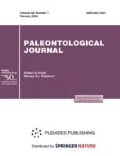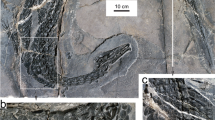Abstract
A new holomorphic petalodont from the Bear Gulch Limestone, Obruchevodus griffithi, is described and features of the related Netsepoye hawesi are reinterpreted. Comparison of these taxa with the holomorphic petalodonts Janassa bituminosa, Belantsea montana, and Siksika ottae provide insight into petalodont anatomical form and variation. All holomorphic material supports holostyly and nested, subcranial branchial arches. Teeth occur in families with linguo-labial replacement but alignment of most families relative to the jaw ramus results in a staggered tooth alignment between adjacent tooth families. Symphysial teeth are the exception to this pattern. Tooth retention is clearly indicated only in the homodont Janassa bituminosa. In contrast there is no evidence of tooth retention in examined petalodonts with a heterodont dentition. There is variation in styles of squamation among all forms; sexual dimorphism in scale development and distribution are suggested as well. Despite depressiform and compressiform conditions there is commonality in possession of a lobular, anteriorly extended and high aspect ratio pectoral fin, large pelvic fins, and absence of fin spines. Pectoral fins provide the primary means of locomotion. Variation in the ventral aspect of the pelvic girdle anatomy exists between that interpreted for Janassa and that documented by Obruchevodus and Netsepoye. Male claspers are long and highly flexible. Laterally compressed body forms display two dorsal fins (first being largest) that are variable in their vertical expanse along the length of the fin. Cranial anatomy shows some correspondence to general features of the Holocephali. Meckel’s cartilage is dorso-ventrally deep, as in extant chimaeroids, with contralaterals in symphysial fusion. Mandibular labial cartilages, when present, may be sexually dimorphic.
Similar content being viewed by others
References
Berg, L.S., Classification of fishes, both recent and fossils, Trans. Zool. Inst. Acad. Sci. USSR, 1955, no. 2, pp. 20–286.
Blake, R.W., Fish functional design and swimming performance, J. Fish Biol., 2004, no. 65(5), pp. 1193–1222.
Brandt, S., Janassa korni (Weigelt)—Neubeschreibung eines petalodonten Elasmobranchiers aus dem Kupferschiefer und Zechsteinkalk (Perm) von Eisleben (Sachsen-Anhalt), Paläontol. Z., 1996, no. 70, pp. 505–520.
Breder, C.M., The shedding of teeth by Carcharhinus littoralis (Mitchell), Copeia, 1942, no. 1, pp. 42–44.
Ginter, M., Hampe, O., and Duffin, C., Handbook of Paleoichthyology, vol. 3D: Chondrichthyes. Paleozoic Elasmobranchii: Teeth, München: Verlag Dr. Friedrich Pfeil, 2010, no. 3, p. 168.
Grogan, E.D. and Lund, R., Debeerius ellefseni (fam. nov., gen. nov., spec. nov.), an autodiastylic chondrichthyan from the Mississippian Bear Bulch Limestone of Montana (USA), the relationships of the Chondrichthyes, and comments on gnathostome evolution, J. Morphol., 2000, no. 243, pp. 219–245.
Grogan, E.D. and Lund, R., The origin and relationships of early Chondrichthyes, in Biology of Sharks and Their Relatives, Boca Raton: CRC Press, 2004, pp. 3–31.
Grogan, E.D., Lund, R., and Greenfest-Allen, E., The origin and relationships of early Chondrichthyes, in Biology of Sharks and their Relatives, 2nd ed., FL, Boca Raton: CRC Press, 2012, pp. 3–30.
Hancock, A. and Atthey, T., Notes on the remains of some reptiles and fishes from the shales of the Nothumberland coal field, Ann. Magazine Nat. History, 1864, no. (4)1, pp. 346–378.
Hancock, A. and Howse, R., On Janassa bituminosa Schlotheim, from the marl slate of Midderidge, Durham, Ann. Magazine Nat. History, 1870, no. 4, pp. 47–62.
Hansen, M.C., Systematic relationships of petalodontiform chondrichthyans, Ninth Int. Congr. Strat. Geol. Carboniferous, Washington and Champaign-Urbana, 1979, Dutro, J.T. and Pfeffercorn, H.W., Eds., in Palaeontology, Palaeoecology, Palaeogeography, Carbondale and Edwardsville, South. Illinois Univ. Press, 1985, vol. 5, pp. 523–541.
Hay, O.P., Bibliography and catalog of the fossil vertebrata of North America, U.S. Geol. Surv. Bull., 1902, no. 179, p. 868.
Jaekel, O., Über die Organisation der Petalodonten, Z. Dtsch. Geol. Ges., 1899, no. 51, pp. 258–298.
Jernvall, J. and Thesleff, I., Tooth shape formation and tooth renewal: evolving with the same signals, Development, 2012, no. 139, pp. 3487–3497.
Lund, R., On a dentition of Polyrhizodus (Chondrichthyes, Petalodontiformes) from the Namurian Bear Gulch Limestone of Montana, J. Vertebr. Paleontol., 1983, no. 3(1), pp. 1–6.
Lund, R., New petalodonts (Chondrichthyes) from the Upper Mississippian Bear Gulch Limestone (Namurian E2b) of Montana, J. Vertebr. Paleontol., 1989, no. 9(3), pp. 350–368.
Lund, R. and Grogan, E.D., Relationships of the Chimaeriformes and the basal radiation of the Chondrichthyes, Rev. Fish Biol. Fisheries, 1997, no. 7, pp. 65–123.
Lund, R., Grogan, E.D., and Fath, M., On the Relationships of the Petalodontiformes (Chondrichthyes), this volume.
Macesic, L.J. and Kajiura, S.M., Comparative punting kinematics and pelvic fin musculature of benthic batoids, J. Morphol., 2010, no. 271, pp. 1219–1228.
Moy-Thomas, J.A., The early evolution and relationships of the elasmobranchs, Bio. Rev., 1939, no. 14, pp. 1–26.
Newberry, J.S. and Worthen, A.H., Descriptions of new genera and species of vertebrates, mainly from the subCarboniferous limestone and Coal Measures of Illinois, Geol. Surv. Ill., 1866, no. 2, pp. 9–134.
Obruchev, D.V., Fundamentals of Paleontology, vol. 11: Agnatha, Pisces, Jerusalem: Israel Program for Scientific Translations, 1967, p. 825.
Ørvig, T., Phylogeny of tooth tissue: evolution of some calcified tissues in early vertebrates, Miles, A.E.W., Ed., in Structural and Chemical Organization of Teeth, New York: Academic Press, 1967, vol. 1, pp. 45–110.
Patterson, C., The phylogeny of the chimaeroids, Philos. Trans. R. Soc., Ser. B, 1965, no. 249(757), pp. 101–219.
Schaumberg, G., Neue Kenntnisse tiber die Anatomie von Janassa bituminosa (Schlotheim), Holocephali, Chondrichthyes aus dem permischen Kupferschiefer, Paläontol. Z., 1979, no. 54(3‐4), pp. 334–346.
Schlotheim, E.F., Die Petrefactenkunde auf ihrem jetzigen Standpunkte durch die Beschreibung seiner Sammlungversteinerter und fossiler überreste der Tier-und Pflanzenreichs der Vorwelt erlautert, Gotha, 1820, p. 437.
Thorsen, D.H. and Westneat, M.W., Diversity of pectoral fin structure and function in fishes with labriform propulsion, J. Morphol., 2005, vol. 263, p. 133–150.
Webb, P.W., Body form, locomotion and foraging in aquatic vertebrates, Am. Zool., 1984, no. 24, pp. 107–120.
Zangerl, R., Chondrichthyes 1. Paleozoic Elasmobranchii, in Handbook of Paleoichthyology 3A, Stuttgart: Gustav Fischer Verlag, 1981, pp. 1–115.
Author information
Authors and Affiliations
Corresponding author
Additional information
The article is published in the original.
Rights and permissions
About this article
Cite this article
Grogan, E.D., Lund, R. & Fath, M. A new petalodont chondrichthyan from the bear gulch limestone of montana, USA, with reassessment of Netsepoye hawesi and comments on the morphology of holomorphic petalodonts. Paleontol. J. 48, 1003–1014 (2014). https://doi.org/10.1134/S0031030114090044
Received:
Published:
Issue Date:
DOI: https://doi.org/10.1134/S0031030114090044




